The Alentejo region of Portugal is a magical place. Situated just north of the famous Algarve coastline, this countryside is steeped in ancient history, dotted with quiet rural villages and stuffed with an amazing variety of good birds. And the coffee, food and wine is out of this world. After staying at the legendary “Paradise in Portugal”, birders should book a first class ticket home to give their bloated bellies a little extra room.
Paradise in Portugal is perched right on the rim of a massive freshwater lake. The owner, Frank McClintock, is a dedicated birder who runs birding excursions from this little slice of Mediterranean paradise. Frank is not only a great birding guide, but he also has a wealth of knowledge about the history of the region and, even more importantly, he maintains a well established wine collection. This is all fine and dandy if you can limit your intake of the delightful stuff. My videographer, Aderman, does not fall into this category. Having him around copious amounts of what he fondly calls “Red Gold” can be potentially damaging to a filming expedition. We were only there for two nights. The first night, knowing that we had a full day’s filming ahead of us and wary of the viticultural table adornments, I sneaked a sleeping pill into his wine-glass and he fell asleep in his food. The second night, unrestrained by sleeping medicine, he behaved like a Philistine on acid. Frank, if you are reading this, I’m really sorry and, if you allow me to come back some day, I promise to leave him behind.
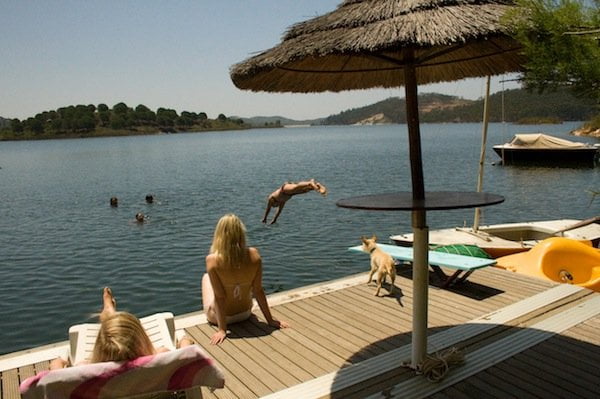 Birding in Portugal is situated at one of the region’s largest freshwater lakes
Birding in Portugal is situated at one of the region’s largest freshwater lakes
 The wildflowers in spring are mind-blowing Frank McClintock
The wildflowers in spring are mind-blowing Frank McClintock
Undoubtedly the major draw-card birding-wise is the healthy numbers of Great Bustards that can be found here. And for those who want a good diversity of other species, the area is a wonderful introduction to the birds of western Europe. When the subject of colorful birds comes up Europe is probably not the first destination that comes to mind. I would bet that for many, European birds conjure up images of drab sparrows, black rooks and brown Acrocephalus warblers. But how wrong this perception can be. Places like Portugal have some truly spectacular bird species. Brightly colored European Rollers, Kingfishers, European Bee-eaters, Blue Rock Thrush, Green Woodpeckers and Golden Orioles to name but a few.
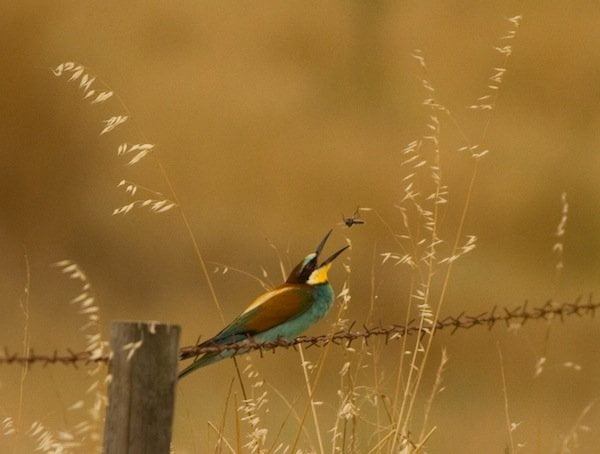 European Bee-eater by Frank McClintock
European Bee-eater by Frank McClintock
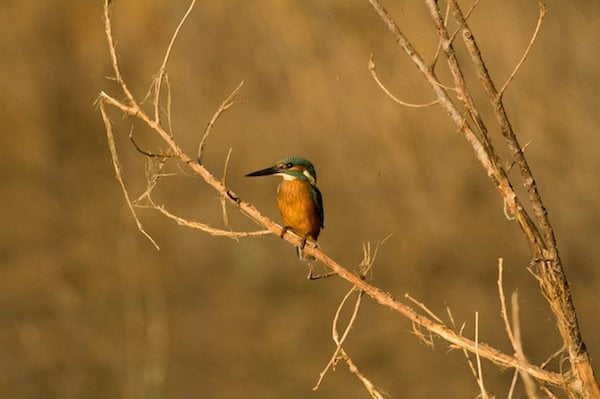 Kingfisher by Frank McClintock
Kingfisher by Frank McClintock
Besides the countryside habitat that holds Great Bustards, there are two really interesting habitat types in the Alentejo that should not be ignored. The first is the splendid cork-oak woodlands that flourish here and the second is the riverine gorges in the east of the region. The cork-oak woodlands (or Montados as they are locally known) are magnets for migrating songbirds and they are protected vehemently by the locals who make wine-corks from the bark, a fitting example of sustainable resource use. These woodlands are excellent habitat for Redstarts, Nuthatches, Chaffinches, three species of woodpeckers, various raptors and the near-endemic Iberian Azure-winged Magpies. In fact the bird parties here can be pretty darn good during summer when most of the migrants have returned. Within the gorges, in particular the Pulo do Lobo, where the river has carved through ancient rock, some really awesome rock speciality species can be found, including Eagle Owl, Bonelli’s Eagle, Black Stork, Crag Martin, Rock Bunting and Blue Rock Thrush.
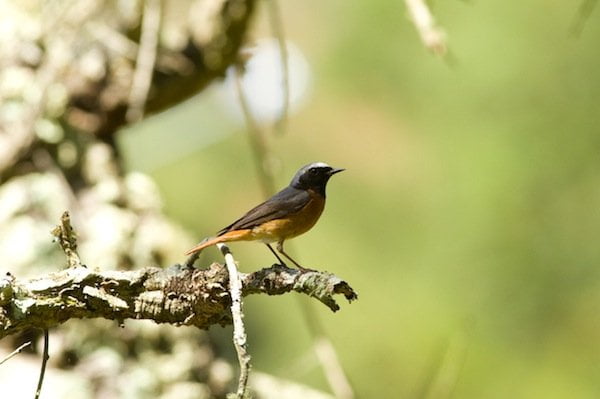 A Redstart in the Montados Frank McClintock
A Redstart in the Montados Frank McClintock
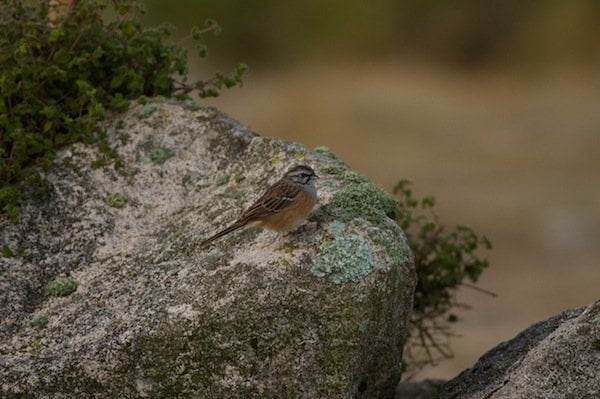 A Rock Bunting at Pulo do Lobo Frank McClintock
A Rock Bunting at Pulo do Lobo Frank McClintock
But without doubt the highlight of a visit to the Alentejo is to explore the wide open stubble fields and plains. Besides the Great Bustards, there is so much to keep a birder occupied here. Little Bustards, Montagu’s and Marsh Harriers, Thekla, Callandra and Crested Larks, Black-eared Wheatears, Tawny Pipits, European Rollers, Black-bellied Sandgrouse, Great Spotted Cuckoos and Little Owls, amongst a whole host of others. But seeing the world’s heaviest flying animal is a pretty unforgettable sight, even if they are viewed respectfully at long range.
httpvh://www.youtube.com/watch?v=mMmlvSozaJo
If you would like to find out more about birding this fantastic place please visit www.birding-in-portugal.com to learn more. But don’t tell Frank you know me. I still owe him money for Aderman’s broken wine-glasses.













I’ve been out on one of Frank’s birding trips and it’s way above the average, interesting even to non-birders. The countryside’s stunning and the birds Frank manages to find are both extensive in numbers and beautiful in context. Highly recommended and well worthwhile staying at the Quinta if you want to get a feel of southern European species while having a fantastic break at the same time – oh, yes, and the food’s mouthwateringly good too!
I have always wanted to visit Portugal, but more for cultural, culinary, and historical reasons…now you have made me want to go there on an exclusive birding trip. Sounds amazing, great description!
Frank is a consummate professional; passionate, knowledgeable, personable and great fun. The Quinta provides the perfect combination of relaxation in a stunning environment and outstanding birding opportunities. Keep it up Franco!
Hi, great video about birdwatching and wildlife tourism in Alentejo-Portugal. Thank you for your “vision” and bird adventures: I want to follow you! Kind regards, José
Thanks jose. You can follow us on facebook at http://www.facebook.com/BirdingAdventures and also on our website at http://www.birdingadventures.com. I do a weekly post every Tuesday right here on 10,000 Birds. Glad you like the show!
hi, great blog post. will come back later.
I am not a birder, but Frank took us too some wonderful areas that we would never have found. He makes the day so interesting, I can’t wait to go again. Daniela is a wonderful hostess, and meals around the table with the other guests makes the day. We have now stayed several times. and would recommend it to anyone who wants a relaxing but interesting holiday. The accomodation is very comfortable and clean. The family and dogs make you feel most welcome. I did learn a lot about birds even saw Bustards in display.